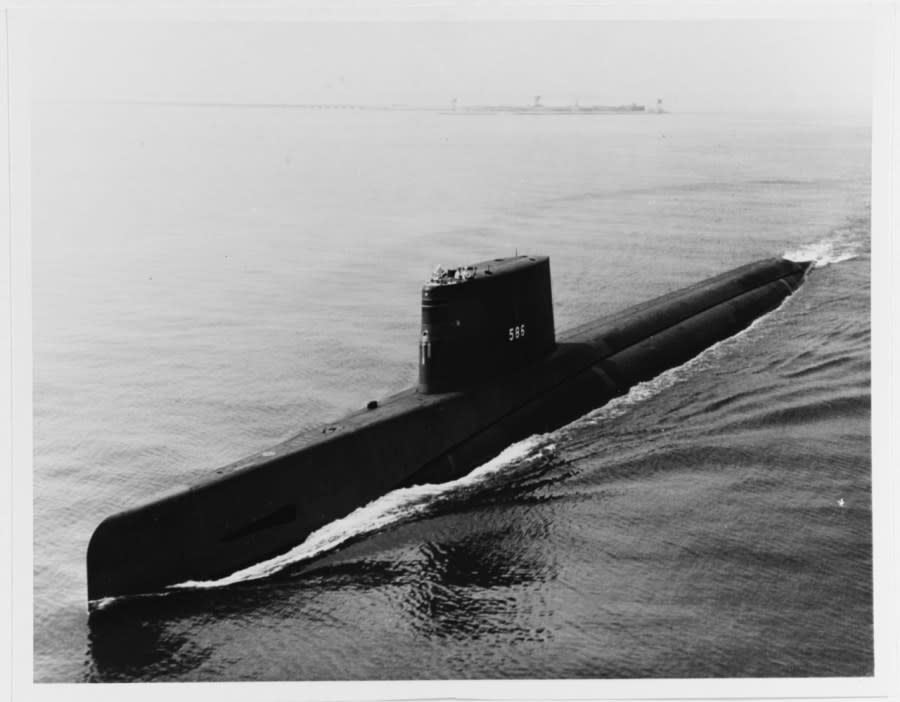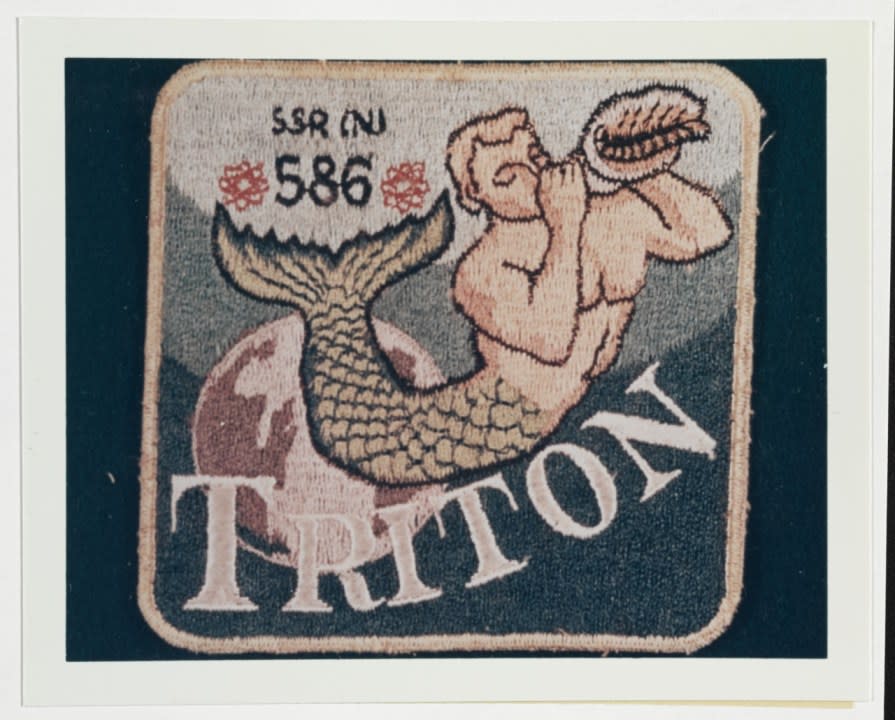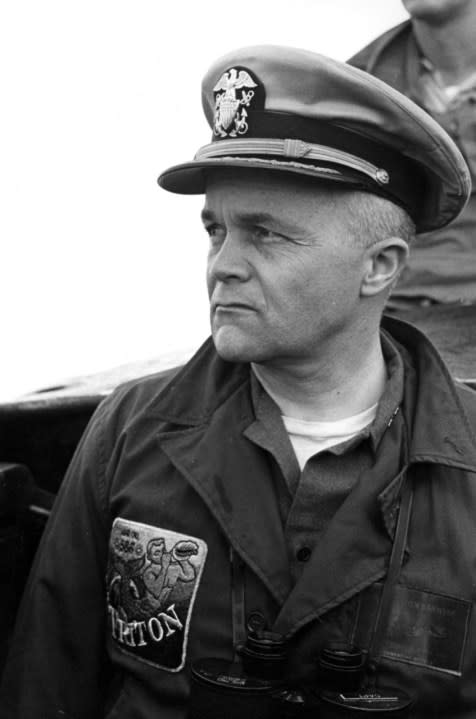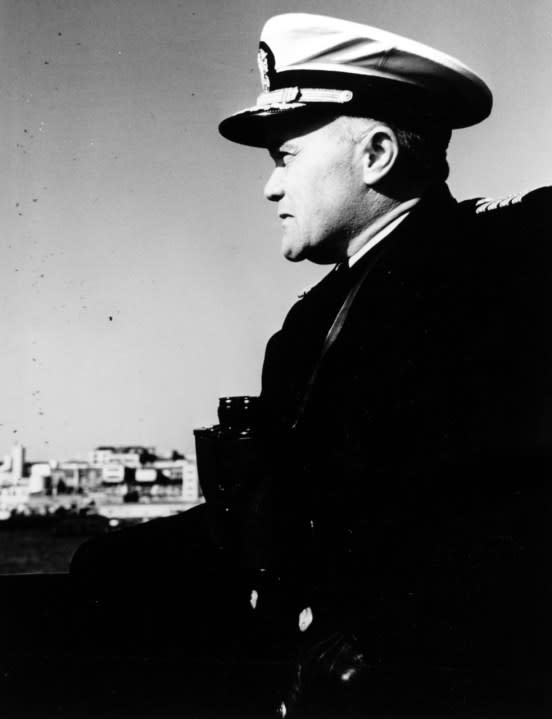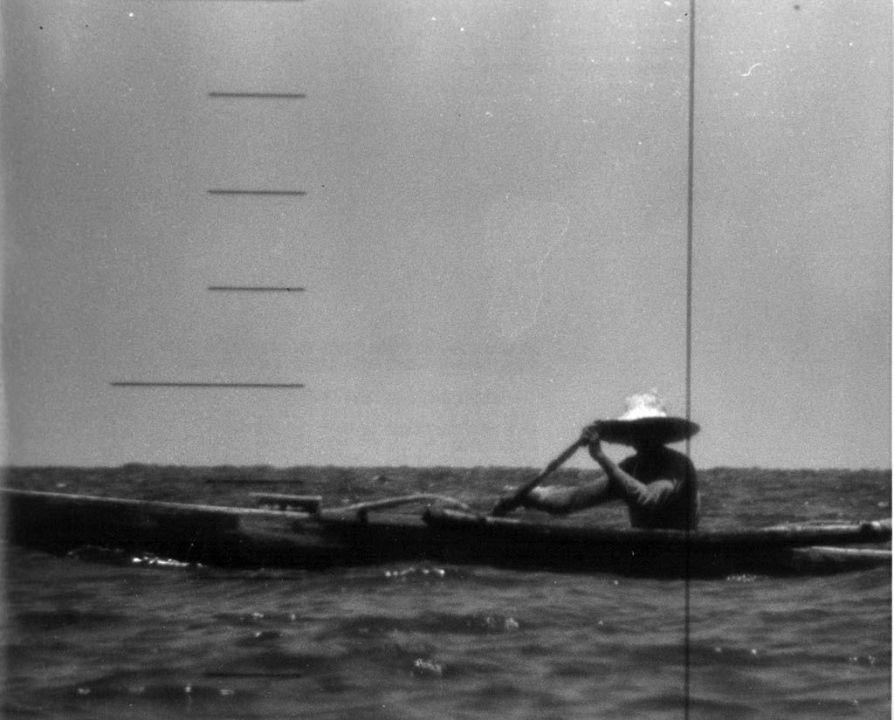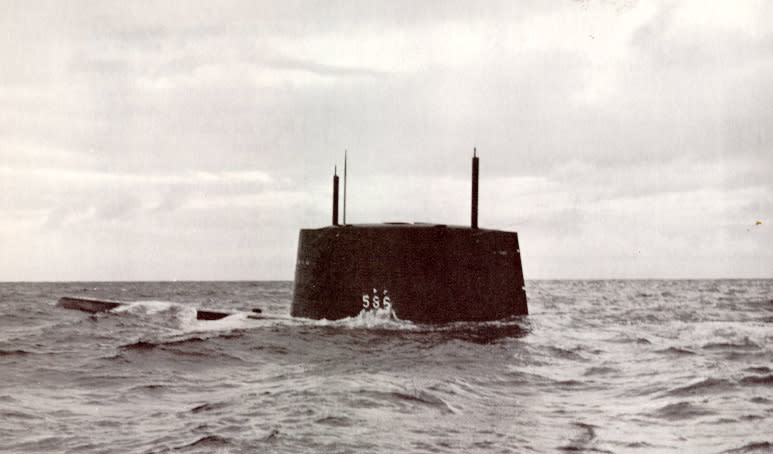On this date: Operation Sandblast began

(WHTM) — She was, at the time, the largest, most powerful, and most expensive submarine ever built. The SSRN-586, aka the USS Triton, was the first nuclear submarine with two reactors, and the only one to ever be built outside the Soviet Union.
Her shakedown cruise in 1960 was as ambitious as the ship’s design. On Feb. 16, 1960, Triton departed New London, Connecticut, to begin Operation Sandblast.
On Feb. 17, Captain Edward L. Beach, skipper of the Triton, announced to the crew what they would be doing:
USS Triton (SSN-586) underway in the Atlantic. (National Archives photograph) Insignia: USS TRITON (SSR(N)-586) (Naval History and Heritage Command) Captain Edward L. Beach, USN, Commanding Officer of the USS Triton (SSBN-586) on the bridge of the submarine immediately after the conning tower breached for the first time after the world’s largest-nuclear submarine completed its historic submerged circumnavigation of the world.” Commanding Officer of USS TRITON (SSN-586) on the bridge of the submarine, 10 May 1960. (National Archive) 19-year-old Rufino Baring of Punta Engano, Mactan Island, encounters the Triton’s periscope, becoming the only unauthorized person to see the sub durinig the voyage. It happened on April Fool Day. (US Navy) Triton surfaces off Cadiz at the end of the voyage. (US Navy)
“Men, I know you’ve all been waiting to learn what this cruise is about, and why we’re still headed southeast. Now, at last, I can tell you that we are going on the voyage which all submariners have dreamed of ever since they possessed the means of doing so. We have the ship and we have the crew. We’re going around the world, nonstop. And we’re going to do it entirely submerged.”
The circumnavigation officially started on Feb. 24, at St. Peter and Paul Rocks, located near the Equator in the middle of the Atlantic Ocean. Triton would return to her starting place on April 25, after traveling 26,723 nautical miles (49,491 km; 30,752 mi) in 60 days and 21 hours. Her average speed was 18 knots/33 km/h/21 mph. Her top speed has been described as “well in excess of” 30 knots.
August 3, 1958: U.S.S. Nautilus reaches North Pole
The overall course of the Triton was a homage to history; it followed much the same path as the first circumnavigation of the world led by Portuguese explorer Ferdinand Magellan (and completed by Juan Sebastián Elcano following Magellan’s death) between 1519-1522. Their route took them down the east coast of South America, through Cape Horn into the Pacific, passing Easter, Christmas, and Hawaiian Islands, past Guam, through Philippine waters and the Indian Ocean, and finally returning to the Atlantic. Along the way, they would cross the equator four times.
Get traffic alerts from the abc27 mobile app for the latest local delays and road closures
Every day Triton would come up to periscope depth to get a navigational fix through a periscope and ventilate the ship through the snorkel. Other than that they stayed totally submerged.
Of course, as the old saying goes, the purpose of a shakedown cruise is to see what shakes and what falls down. Triton faced some serious problems during the voyage; the fathometer failed, meaning they could no longer echo-locate the sea floor, and readings on one of the reactors indicated a malfunction, forcing a shutdown. A seal on the starboard prop shaft sprang a major leak, a gyroscope malfunctioned, and near the very end of the journey, a hydraulic line to the stern plane mechanism burst, forcing steering to be performed for the remainder of the voyage in emergency mode.
April 11, 1900: U.S. Navy’s first “modern” submarine
The problems were all dealt with-they came up with several solutions to the fathometer problem, the reactor was restored to service, seals were resealed and leaks were locked down. But the event that most endangered the mission was human illness. One of the crew suffered an attack of kidney stones, which became so severe it was obvious he needed to be evacuated for medical treatment. The Triton was able to rendezvous with the heavy cruiser USS Macon. They brought the submarine up until the top of the sail was just broaching the water, leaving the sub’s hull underwater, and they were able to transfer the sailor to a whaleboat without technically surfacing.
The voyage tested the abilities of a crew to perform during prolonged isolation from the outside world-useful information for both submarining and spaceflight. (A psychologist was on board to monitor the crew.) They also collected water samples, mapped the sea floor, and measured Earth’s gravitational field variations. They also discovered multiple seamounts.
For their efforts, the crew of the Triton received the Presidential Unit Citation and Captain Beach received the Legion of Merit from President Dwight D. Eisenhower.
But in just a few years Triton was obsolete. She’d been designed as a radar picket ship, meant to sail ahead of a fleet to provide early warning of oncoming unfriendlies. But at the same time Triton was being built, it was becoming obvious the airborne early warning (AEW) aircraft could do the job better and cheaper.
Stay up to date on the latest from abc27 News on-air and on the go with the free abc27 Mobile app.
In 1962 she was converted into an attack submarine. Her size and power made her ideal as a flagship for COMSUBLANT (Commander, Submarine Force Atlantic). Triton served in that capacity until 1967. She was decommissioned in 1969, and broken up at the Nuclear Powered Ship and Submarine Recycling Program (SRP) at Puget Sound Shipyard in 2009. The Triton’s sail is on display at the USS Triton Submarine Memorial Park in Richland, Washington.
In the early 1960s, ABC ran a documentary series called Expedition! On Tuesday, Feb. 14, 1961, just short of a year after Triton began her voyage, the show aired an episode about Operation Sandblast called “Saga of the Triton.” To view that episode, click here.
For the latest news, weather, sports, and streaming video, head to ABC27.
